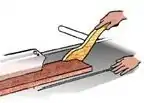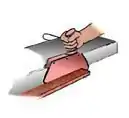A push stick, push shoe, or push block is a safety device used when working with stationary routers, jointers, or power saws such as table saws or bandsaws.[1] The purpose of a push stick is to help the user safely maneuver a workpiece, keeping it flat against a machine table or fence while it is being cut.

When ripping narrow stock, a push stick or block is used to prevent the operator getting too close to the blade.
Types of push sticks
There are several different categories of push sticks, and many people adapt their own designs.
- Push shoes are push devices categorized by a long section to gain more control over the workpiece, and are typically L-shaped.
- Push stick can be a general term to refer to all push devices, or to a specific type categorized by a long handle with a notch in the end.

A long push stick, used for pushing narrow stock through a table saw
- Push blocks typically are made from a thick block of wood with a handle and a hook on the back to hold onto the workpiece.
 A push block, used on a table saw
A push block, used on a table saw - Push pads typically consist of one or two handles and a flat pad with a rubber underside to increase friction with the workpiece. They are typically used with jointers and router tables.
- Microjig's GRR-Ripper is a hybrid push device that combines characteristics of a push block with a push pad. It uses an adjustable base which allows it to straddle a table saw blade or be used as a push pad.[2]
References
- ↑ "Woodworking Machines - Push sticks", Canadian Centre for Occupational Health and Safety
- ↑ Jeffrey Fleisher, "Micro Jig GRR-Ripper Advanced GR-200 System - Tool Review", Wood News Online
This article is issued from Wikipedia. The text is licensed under Creative Commons - Attribution - Sharealike. Additional terms may apply for the media files.